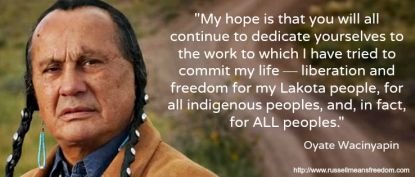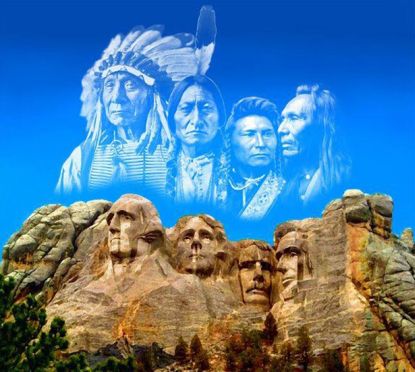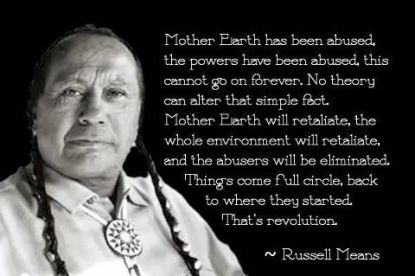
Russell Means, baptized Oyate Wacinyapin, which means 'works for the
people' in Lakota, died on Oct. 22. A towering figure among indigenous
peoples, those who oppose injustice across the world mourn his passing.
Russell Means Reminded
the World of the Real America (Izvestia, Russia)
"I don? know
what his life teaches Americans. But for me, he was the figure who links the
America we know from history books to the America of today, in which
presidential candidates debate whether homosexuals should be able to marry.
Means made it possible to respect this country. It turned out that everything we
loved about it as children was more than just a shadow on a movie screen, but a
physical reality."
By Orhan Jemal

Translated By Casey Patrick Reilly
October 27, 2012
Russia - Izvestia - Original Article (Russian)
The real life Chingachgook has died. Only
as an adult did I learn of his existence. The Chingachgook
of my childhood was a fake. I knew that actor Gojko Mitic was not an Indian, but a Serb.
Russell Means, however, was a real Sioux. But it was his life and not his
origins that made him a genuine hero and not just a cinematic one.
He became an actor at the age of 50, playing the renowned
Indian chief and warrior. But up until then, he had never played anyone. He was
simply an Indian chief and warrior who fought the White man his entire life.
Means got his start with the desecration of a monument to
the first American president. It was just minor symbolic hooliganism: in 1970,
a group of activists associated with the American Indian
Movement relieved themselves on the head of George Washington, carved out
of an entire mountain in the town of Rushmore. It didn? attract much attention,
as there were plenty of unconventional people in the U.S. at the time, but Means and his
comrades had no intention of stopping there.
U.S. mythology understands the story of
Thanksgiving Day thus: British settlers, who journeyed to America on a three-masted ship, The Mayflower, founded the Plymouth
Colony [in 1621]. In the first winter they died like flies from starvation, and all would
have perished if not for the local chief Tisquantum, who
gave the settlers some turkeys and bags of corn. This sharing of a common
table with their Indian saviors came to be celebrated as a major American
holiday.
On Thanksgiving Day, he appeared at Plymouth and ?poiled
the party.·/p>
Means led hundreds of Indians to Plymouth and held a series
of protest marches, recalling as
it really was: about 1,000 Indians, including women and children, gathered
at the harvest festival. They were surrounded, the men were shot, the women and
children burned and the severed head of their chief was mounted on a pike and
left to rot for 24 years. The next day, the governor of the colony declared a day
of "Thanksgiving" for their God-given victory over the savages. That
was how America's biggest holiday was marked for the first time.
Posted
by Worldmeets.US

Mount Rushmore: One of
America's greatest national monuments is,
to Native Americans, one of
the most inflammatory and blasphemous
symbols of what was taken
from them.
This was now a fully-fledged scandal that attracted
attention even outside the United States, but it still fit within the rules of
the time. This was the era of The Beatles,
hippies, "Black Panthers" and the anti-war movement - all of America's
informal heroes were young nonconformists.
Two years later, the young Indian was one of the organizers
of the "Trek of Violated Treaties." A petition calling on the United
States to comply with 19th century treaties agreed to with the Indians was
brought to Washington. It was a question of returning land that the government had
recognized as Indian, based on these signed documents. The delegation was not
received, and police even attempted to disperse the guests arriving in war
paint. In response, Means organized the seizure of the Bureau of Indian Affairs
building, holding it for almost a week. The government was afraid to put Means
and his comrades on trial. There was a whiff of Indian rebellion in the air.
Despite this caution, rebellion occurred that
same year. In the town of Castor, a White man publicly stabbed an Indian and was
acquitted by a local court. Then, on the day of his acquittal, police beat the victim's
mother. For all of the following day, Means' Indians burned police cars and chased
the cops all over the city. They then climbed the hill in the village of Wounded
Knee, where in 1890, there was a battle between
Indians and Whites (the Indians call this incident a massacre - not a battle).
From there, Means and his comrades proclaimed an independent Indian republic, and
took up defensive positions.

SEE ALSO ON THIS:
Le Monde, France: Sioux Indians of Lakota Tribe Tell State Dept. of Succession
Indian Country Today: The Death of Russell Means:
Let Us Examine His Journey
Indian Country Today: Russell Means, Lightning and Sexiness: The Toughest Indian
Indian Country Today: Russell Means: A Hero Moves On
Die Zeit, Germany:
Romneysia Hits Lakota Country
It went on for 70 days. The F.B.I. lost two men in
firefights, and under the mediation of the Association of American Churches, the
Indians finally laid down their weapons. The government has never fulfilled the
conditions under which the Indian rebels surrendered. Some of the rebels were
tried, but were acquitted.
The last time he took up arms was in 1986. With a detachment
of volunteers, he went to Nicaragua to protect Miskito
Indians from the red [communist] Sandinistas who had taken power (with the help
of the CIA who were in the midst of aiding the Contras during a civil war). And
this, despite the fact that throughout previous years, conservative America
denounced him as a communist, a Maoist. But in fact he was just a fighter for
his people, the same as the great Indian leaders of the 19th century, Sitting
Bull, Crazy Horse, Red Cloud.
YOUR DONATION MAKES OUR WORK AS
A NON-PROFIT POSSIBLE. THANK YOU.
Already middle-aged, Means' friends persuaded him to act in
films (he was a friend to Oliver Stone and Marlon Brando). And so it transpired
that he depicted Chingachgook. It wasn't hard for
Means. He was just playing himself. Still, his biography's final chapter doesn't
indicate that his blood cooled with age, or that he became "a useful
member of society."
I don? know what his life teaches Americans. But for me, he
was the figure who links the America we know from history books to the America
of today, in which presidential candidates debate whether homosexuals should be
able to marry. Means made it possible to respect this country. It turned out
that everything we loved about it as children was more than just a shadow on a
movie screen, but a physical reality.